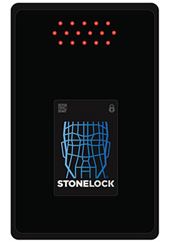Despite the difficult economic conditions in which it is operating throughout the world, the security industry appears to be 'weathering the storm' relatively well. Although some impact from the economic downturn is, of course, being experienced, the industry is probably less affected than other sectors. This is presumably because, even in difficult times, people recognise the importance of security and, in the face of growing unemployment and higher crime rates, are looking to protect their assets. Access control continues to be a major element of the security mix, although it is now more often part of an integrated approach to protection. This is because integration and interoperability are primary drivers in today's market, with end-users looking not only to the benefits in terms of security but also beyond. There is a movement away from the 'single discipline' purchase, certainly with more sophisticated installers and bigger customers, to a more holistic approach to building technology - with security integrating with general business and building processes. Previously, the various security disciplines were all 'stand-alone' technologies that only offered the possibility to connect and communicate either at very low level via hard-wired signals or at a very high level by means of bespoke software applications, developed by system integrators operating in the market.
Plug and play mentality
For years, access control systems with their databases and transaction logs, have utilised the IP (the principal Internet communications protocol) of the computer systems within the buildings they serve. Video surveillance, having undergone the change to the digital environment, is now using the same infrastructure, thus making integration even more viable. Customers themselves are also becoming more aware of the total cost of ownership of the security systems of their buildings - from the planning phase, through installation, training, maintenance and future extendibility. As their personal IT competence grows and they become more alert to the possibilities of IT, so their expectations increase. Many have a 'plug and play mentality' brought about by their own use of computers at home and at work, and so they are now increasingly expecting the interface of their security systems and software to operate in a similar, simple way - not just across the different brand lines of a single vendor's proprietary technology but between the systems of different manufacturers.
The move towards open standards in physical access control
Most forward-thinking participants in the market already acknowledge the need to develop standardised interfaces for network security systems. The driving ambition is to make it even easier for end users, integrators, consultants and manufacturers to take advantage of the possibilities offered by network solutions and to bring benefits to the whole industry. An open standard for the interface of all network products would enable installers to integrate products from different manufacturers into a single system. The standard will also help software vendors to ensure that their products support various brands of network products. For product manufacturers, an open standard ensures interoperability with other manufacturers. In this environment, systems could be updated or upgraded with products from a choice of different manufacturers, rather than being confined or 'locked' to the product ranges of a single manufacturer. Within the network video market, many of the benefits of open standards are already being experienced. ONVIF (Open Network Video Interface Forum), currently the largest body in terms of membership and market penetration, is a global forum, membership of which is open to manufacturers, software developers, consultants, systems integrators, end-users and other interest groups that wish to participate.
The ONVIF specification for video currently defines a common protocol how network video devices exchange information such as live video, audio, metadata and control information. Conformant network video transmitters, e.g. cameras or encoders, and receivers from different participating ONVIF manufacturers are able to communicate with each other by requesting and sending live view video streams. The specification also ensures that conformant devices are automatically discovered and connected to network applications such as video management systems. The technology used by the ONVIF specification, Web Services, is equally suitable for other applications/devices such as access control - and at the end of March 2010, ONVIF announced that the scope of standardisation was being extended to cover physical access control. In the future, access control devices from manufacturers that comply with the ONVIF standards will not only interoperate effortlessly and seamlessly with each other, but also with ONVIF-conformant video surveillance products and systems -without the need to make any specific set-up adjustments during commissioning.
The benefits of open standards in physical access control
As a result of the ONVIF collaboration, it should one day become possible to ensure interoperability between all network products of participating manufacturers, regardless of brand. The focus on video enabled the forum to work efficiently to have everything in place - core specification, test specification, test tool and conformance process to achieve real interoperability of participants' products in a relatively short time-frame. Having such elements in place should make it easier for companies to develop other fully interoperable devices such as those used in access control. This, in turn, will allow end-users, integrators, consultants and manufacturers to take advantage of the possibilities offered, resulting in more cost-effective and flexible security solutions, expanded market opportunities and reduced risk.
For the end-user, it will create the flexibility to choose products from different manufacturers in order to create the most suitable, practical, effective and cost-efficient access control solution. For the manufacturer, it offers the possibility to enter new security areas by having the ability to interface with systems and solutions from various integrators. For the integrators, it offers greater flexibility with the ability to offer customer-specific solutions, rather than those based around the products of a single manufacturer.
Integration possibilities for physical access control with video systems
The possibility of integrating access control and video surveillance systems is currently restricted to the use of products from either a single manufacturer or those products from manufacturers with specific integration possibilities. With the development of an ONVIF standard for access control products, the integration complexity of various field devices provided by different suppliers will be reduced. There will inevitably be savings in time and costs for manufacturers (in the development of new products and systems), installers and end-users and integration risks and problems will, of course, be minimised.
By October 2010, six months after the initial announcement that ONVIF, already the leading standardisation initiative for network video products, was extending its scope to include the physical access control systems, ten leading companies had already undertaken to contribute to the working group.
The scope of standardisation in physical access control
The establishment of open standards within video is already helping to drive the migration from analogue to digital solutions, bringing the benefits of network video available to everyone along with interoperability, flexibility, quality and future-proofing.
By expanding the ONVIF scope to include access control, the forum is taking a further step in facilitating the integration of IP-based security and safety devices using a global open standard. Standardisation within access control has started with the definition of main application/use cases, establishing the basic technical architecture and the creation of interfaces for basic functions with the emphasis on system expandability. Main nodes in the drafted architecture are the Identification Point (e.g. a credential reader), the door infrastructure and an Authentication and Authorisation Engine. The first drafts are scheduled to be available early in 2011.
Open standards are the future
Providing a truly comprehensive, long-term security solution today requires more than one manufacturer's state-of-the-art technology. It requires the provision of a means for contemporary systems not only to communicate with each other but also, with systems of the future. At Siemens, we believe the future of security management lies in open standards because the full potential of today's technologies will be realised only by creating compatibility between different brands. We choose to support ONVIF, because it is forward-looking, based upon current IT infrastructures and its Web Service-base facilitates fast and simple integration, enabling a broad, device-support capability. As a leading player in the market, Siemens has already begun introducing standardised interfaces in the video processing chain, is now looking to do the same with access control systems and it is our stated intention, through ONVIF, to expand the quest for open standards into other suited security disciplines.
09/03/2011















